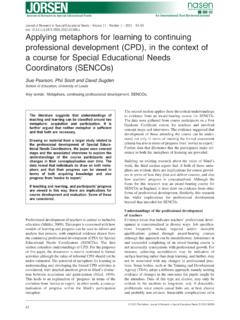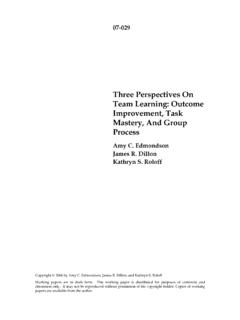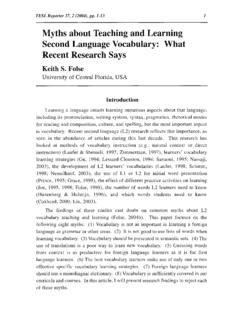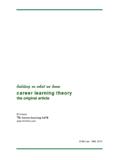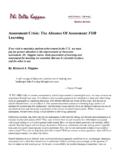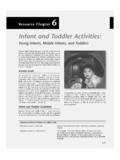Transcription of Blended Learning Complete - Pedagogy, Culture, …
1 1 Report: Defining Blended Learning Norm Friesen, August 2012 Blended Learning appears to have been in use since the popular advent of the Internet and the World Wide Web in the late 1990s. However, like many other Internet buzzwords around this time ( , new economy, e Learning ), its precise connotations have changed and subsequently converged and stabilized. From 2006 to the present, Blended Learning has been understood as a combination of face to face and technology mediated instructional forms and practices. At the same time, the phrases face to face and technological mediation themselves may generally benefit from further definition and contextualization. As a result, this paper traces out the etymology of the evolving meaning of the term Blended Learning , and it also maps out analytically the significance of the opposed terms that have come to be seen as Blended in it.
2 It offers these etymological and analytical accounts in order to provide clarity on the current meaning of Blended Learning . Part I: History and Etymology a. Origin and Divergence: 1999 2004 The precise origin of the term Blended Learning is uncertain. However, one of the first occurrences that have been identified is its use in a 1999 news release from EPIC Learning , an Atlanta based computer skill certification and software training business: The company currently operates 220 on line courses, but will begin offering its Internet courseware using the company's Blended Learning methodology [sic]. Select courses will continue to offer the traditional course content online, but will also offer live instruction and other collaborative components, all from the student's desktop. (PR Newswire, March 5, 1999, ; emphasis added) The definition of Blended Learning implied in this announcement is ambiguous: Does live instruction suggest the physical co presence of instructor and student?
3 Or does it mean that the instructor is online EXECUTIVE SUMMARY: The meaning of Blended Learning has changed over time; only definitions from 2006 and later are to be considered current. Consequently, a suggested composite definition is: Blended Learning designates the range of possibilities presented by combining Internet and digital media with established classroom forms that require the physical co presence of teacher and students. The coherence and consistency of this definition is illustrated through examples from the literature, and via a decision tree offered as a heuristic. 2 at the same time as the student? Is the student s desktop a literal place, or is it the virtual one simulated on a computer screen? Questions of these kinds are multiplied when other, relatively early definitions of Blended Learning are consulted. For the years 2002 2003 in particular, many eclectic definitions of Blended Learning seem to be available.
4 For example: Blend ed learn ing v. [sic] 1. To combine or mix modes of web based technology ( , live virtual classroom, self paced instruction, collaborative Learning , streaming video, audio, and text) to accomplish an educational goal. 2. To combine various pedagogical approaches ( , constructivism, behaviorism, cognitivism) to produce an optimal Learning outcome with or without instructional technology. 3. To combine any form of instructional technology ( , videotape, CD ROM, web based training, film) with face to face instructor led training. 4. To mix or combine instructional technology with actual job tasks in order to create a harmonious effect of Learning and working. The point is Blended Learning means different things to different people. This may appear to be an academic point but in reality these definitions illustrate the untapped potential of Blended Learning .
5 (Driscoll, 2003, p. 1) Blended Learning , in other words, is almost any combination of technologies, pedagogies and even job tasks. It includes some of the oldest mechanical media ( , film) and theories of Learning ( , behaviourism), as well as the newest. It is therefore not surprising that EPIC Learning , having referenced Blended Learning methodologies earlier, found themselves trying to clarify their own use of the term. In a white paper written specifically for this purpose, another example of a definition is quoted this time from training sector expert Elliot Masie which is so broad as to again include nearly all forms of Learning and instruction: What is Blended Learning ? It is the use of two or more distinct methods of training. This may include combinations such as: blending classroom instruction with online instruction, blending online instruction with access to a coach or faculty member, blending simulations with structured courses, blending on the job training with brownbag informal sessions, blending managerial coaching with e Learning activities.
6 (from: Clark, 2003 p. 4) This white paper goes on to define Blended Learning as a mix appropriate to training and job performance, one which would include performance support technologies, knowledge management and online training technologies. It is likely that the very breadth and inclusivity of these definitions of Blended Learning , as Driscoll suggests, initially helped make the term popular as a buzzword. Although these early definitions provide 3 little clarity in including or excluding courses in Blended Learning , the way the term is defined or described indicates at least three things about this type of Learning : 1. First, in contradistinction to the Driscoll definition, Blended Learning is a noun or a noun phrase (a gerund), not a verb. This underscores that it is not so much about students activity (as in: I m Blended Learning today ), as it is a method of instruction, of greater concern to instructional and institutional personnel.
7 2. Although Blended Learning can involve a combination of any number of technologies and techniques, most examples include only two, for example: classroom with online, online with coaching, instructional technology with actual job tasks, etc. 3. Finally, the combination of classroom with online activities or modalities is conspicuous in the two definitions cited above (and in other examples from this time; , Singh & Reed, 2001; Orey, 2003). b. Consolidation and Clarification: 2006 2012 The middle of the first decade of the 21st century marks a shift in the use of the term Blended Learning : The importance of this term in the higher education context (rather than industry and training) became clear, as did a broadly consensual understanding of its meaning. 2006 is the year of the publication of the first Handbook of Blended Learning , (Bonk, Graham, Cross & Moore), and a year later, the book Blended Learning in Higher Education: Framework, Principles, and Guidelines by Randy Garrison and Norman Vaughan appeared.
8 The first of these books was introduced with a chapter titled Blended Learning Systems: Definition, Current Trends, and Future Directions, by Charles Graham. This chapter works towards a definition of Blended Learning that has come to be widely accepted; and it does so by first reviewing the very broad kinds of definitions cited above, and then concluding: these positions suffer from the problem that they define [ Blended Learning ] so broadly that they encompass virtually all Learning systems. One would be hard pressed to find any Learning system [or combination of methods] that did not involve multiple instructional methods and multiple delivery media. (Graham, 2006, p. 4) Speaking specifically of Blended Learning systems (from a systems theory rather than a technical perspective), Graham then goes on to define such systems as ones that combine face to face instruction with computer mediated instruction (p.)
9 5). He justifies this approach as follows: Th[is] working definition .. reflects the idea that [ Blended Learning ] is the combination of instruction from two historically separate models of teaching and Learning : traditional F2F Learning systems and distributed Learning systems. It also emphasizes the central role of computer based technologies in Blended Learning . (2006, p. 5) Graham s definition and explanation are particularly helpful in that they reference traditions, practices and norms with which many educators will be long familiar. These are practices and norms of the physical, bricks and mortar classroom on the one hand, and of distance delivery (presumably including 4 postal correspondence through teleconference to fully online methods) on the other. Graham continues this differentiation by explaining that Blended Learning is part of the ongoing convergence of [these] two archetypal Learning environments.
10 On the one hand, we have the traditional F2F Learning environment that has been around for centuries. On the other hand, we have distributed Learning environments that have begun to grow and expand in exponential ways as new technologies have expanded the possibilities for distributed communication and interaction. (2006, p. 5) Garrison and Vaughan, for their part, cite Graham s definition in their 2007 book, and portray Blended Learning , thus defined, as having a natural place in higher education contexts. Furthermore, in distinguishing between online and classroom settings, Garrison and Vaughan emphasize the particularly textual nature of many online contexts as opposed to the oral communication typical of the classroom: Recognizing true Blended Learning is not obvious. Blended Learning is the thoughtful fusion of face to face and online Learning experiences.
